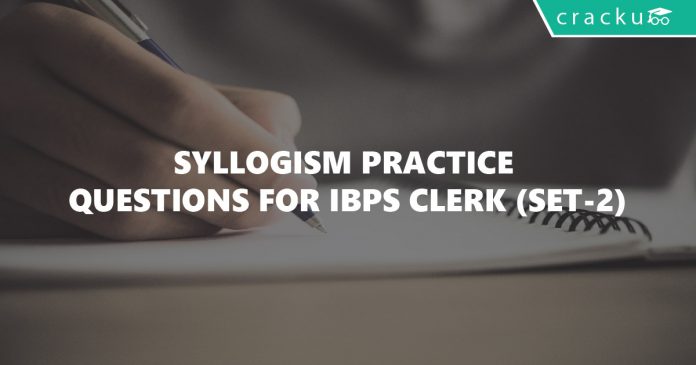Syllogism Practice Questions for IBPS Clerk (Set-2):
Download IBPS Clerk Syllogism Questions set-2 PDF
75 IBPS Clerk Mocks – just Rs.199
IBPS Clerk Free Mock Test-2018
Download all IBPS clerk questions and answers PDF.
Download all GK ebooks for Banking exams
Instructions:
In each of the questions below are given two statements followed by three conclusions numbered I, II and III. You have to take the given statements to be true even if they seem to be variance from commonly-known facts. Read all the conclusions and then decide which of the given conclusions logically follows from the given statements disregarding commonly-known facts.
Question 1:
Statements:
Some pencils are houses
All houses are buses.
Conclusions:
I. Some pencils are buses.
II. Some buses are pencils.
III. All buses are pencils
a) All follow
b) None follows
c) Only II follows
d) Only I and II follow
e) None of these
Question 2:
Statements:
No train is star
Some stars are men.
Conclusions:
I. Some men are trains
II. No men is train
III. All men are stars
a) None follows
b) Only I follows
c) Only either I or II follows
d) Only either II or III follows
e) None of these
Download all General Knowledge Questions and Answers for Competitive exams PDF
Question 3:
Statements:
Some trees are roads.
All roads are stones
Conclusions:
I. All trees are roads
II. Some stones are trees
II. No stone is tree
a) Only either II or III follows
b) Only either I or II follows
c) Only either I or III follows
d) Only II follows
e) None of these
Question 4:
Statements:
All books are cars
All cars are tigers
Conclusions:
I. All books are tigers
II. All tigers are books
III. All cars are books
a) Only I follows
b) Only II follows
c) Only I and II follow
d) All follow
e) None of these
100 Free GK tests for Banking (Download App)
Question 5:
Statements:
All books are pins
Some pins are desks
Conclusions:
I. Some desks are books
II. All desks are pins
III. No desk is book
a) Only either I or II follows
b) Only either I or III follows
c) Both I and III follow
d) Only I follows
e) None of these
Solutions (1 to 5)
1) Answer (d)

We use elimination to find an exception to the generality of the conclusions. Thus we prove they are not implied. The diagram above satisfies all the statements but contradicts conclusion III. Since we found an exception, the conclusion is not true in “every” case. Thus it is not implied.
We can draw many scenarios that satisfy the statements using Venn diagrams and check for the validity of the conclusions. Conclusions I and II hold in every case. So, they are implied.
2) Answer (c)

We use elimination to find an exception to the generality of the conclusions. Thus we prove they are not implied. The diagram above satisfies all the statements but contradicts conclusion III. Since we found an exception, the conclusion is not true in “every” case. Thus it is not implied.
Irrespective of the diagram, conclusions I and II are universally complimentary ie. one of the two always has to be implied but both can’t be true at the same time. Hence we use “either” and “or”.
Download IBPS Clerk Prelims Question Paper 2016 PDF
3) Answer (d)
We use elimination to find an exception to the generality of the conclusions. Thus we prove they are not implied. The diagram below satisfies all the statements but contradicts conclusions I and III. Since we found an exception, the conclusions are not true in “every” case. Thus they are not implied.
We can draw many scenarios that satisfy the statements using Venn diagrams and check for the validity of the conclusions. Conclusion II holds in every case. So, it is implied.
4) Answer (a)

In a subset, we can say “all” it’s elements belong to the super-set. But the reverse is not true. ie all the elements of a super-set don’t belong to a sub set.
IBPS Clerk Expected Questions 2017
5) Answer (b)

We use elimination to find an exception to the generality of the conclusions. Thus we prove they are not implied. The diagram below satisfies all the statements but contradicts conclusion II. Since we found an exception, the conclusion is not true in “every” case. Thus it is not implied.
Irrespective of the diagram, conclusions I and III are universally complimentary ie. one of the two always has to be implied but both can’t be true at the same time. Hence we use “either” and “or”





![How To Manage Time In CAT Exam? [Section-wise Tips] How to manage time in CAT exam ?](https://cracku.in/blog/wp-content/uploads/2018/09/fig-03-09-2018_10-54-46-218x150.jpg)